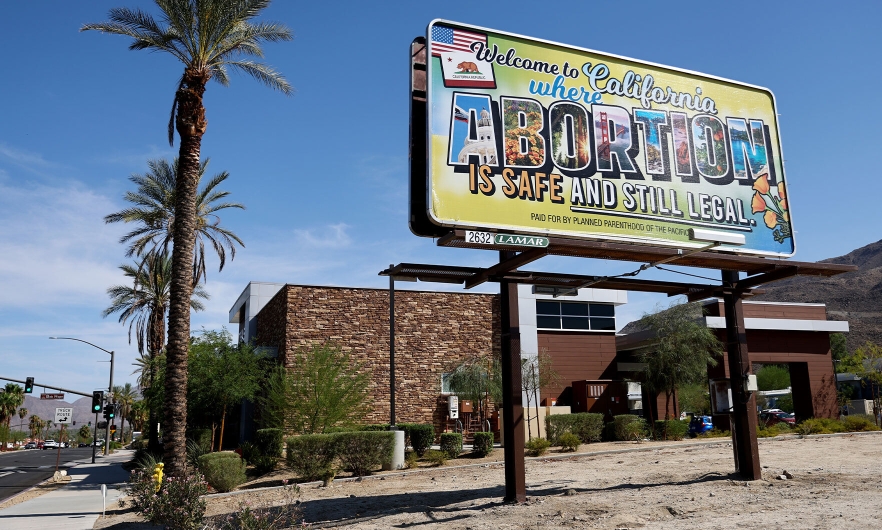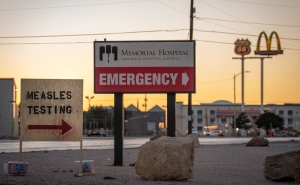Abortion Access After the Dobbs Decision

A billboard in Rancho Mirage, California, July 12. Planned Parenthood clinics in San Bernardino and Orange counties saw a 900% increase in patients from out of state the week following the Supreme Court’s Dobbs decision.
Since the reversal of Roe v. Wade in June 2022, several states have moved to either protect, significantly restrict, or ban abortion.
In this Q&A, adapted from the January 4 episode of Public Health On Call, Josh Sharfstein, MD, speaks with legal and public health expert Joanne Rosen, JD about what’s happening in the states—including threats to medication abortion, the chilling effect changes are having on practitioners, and how the recently passed Respect for Marriage Act is protecting rights that might have been erased by a ruling similar to the Dobbs decision.
About six months ago, the Supreme Court released the Dobbs decision, which ended the constitutional right to an abortion. What have we seen happening at the state level since then?
It’s been a really busy six months. Abortion is no longer available at all in 14 states, and it looks like that may be just the beginning of state actions to ban abortion. The Guttmacher Institute has estimated that 25 or 26 states are likely to ban or significantly restrict abortion. At the moment, in addition to the 14 states that have banned abortion, eight states have introduced bans that are currently blocked by court order. So there’s been quite a lot of movement to ban or significantly restrict abortion.
The case has also sparked legislation and action in states that are supportive of abortion rights. What’s been happening there?
Yes, that’s absolutely true. During the most recent legislative session, in anticipation of the outcome of Dobbs, many states introduced new legislation to further protect abortion access. A number of these states introduced protections for doctors who perform abortions—protecting them against lawsuits or claims from other states in the event that they perform abortions on women who travel into those states from states that have banned abortion.
Maryland was among a handful of states that took steps to increase the number of health care professionals who would have the necessary credentials to perform abortions, so that they would have a critical mass of providers to deal with an anticipated increased demand from women traveling into these more protective states [to seek care]. Fifteen states and Washington, DC, took measures to protect both abortion access and the people who perform abortions.
What about the legal gray area of what one state can do to try to limit what happens in another state? Can a state say you can’t travel for an abortion, for example? Can a state make an abortion provider a criminal for performing an abortion in another state?
These are still wide-open legal questions. There is no explicit constitutionally protected right to interstate travel, but historically, states are only able to legislate matters that take place within their boundaries. So if a pregnant person travels from Texas, let’s say, to Maryland to get an abortion, could Texas prosecute her upon her return? Or could Texas prosecute the doctor who performs the abortion?
Historically, it would look like that shouldn’t happen, but it’s still an open legal question, which is why some states have introduced legislation to protect the doctors within their boundaries.
But the possibility of a state legislating outside its borders and going after doctors in other states has already had a chilling effect in some states. There are doctors who may be licensed in multiple jurisdictions, including those that have banned abortion. They don’t perform abortions where they’re banned, but those states have said that they could discipline those doctors or suspend their licenses, even though the services they’re providing are lawful in the states in which they’re providing them. I’ve heard from physicians who perform abortions and are licensed in multiple states that they are deeply concerned about this.
What about ballot initiatives?
As we all know from the midterm elections [in November], five states had abortion-related matters on their ballots. Three of the ballot initiatives were abortion protective, and two were really abortion restrictive. The abortion protective measures all passed—including a constitutional amendment in California that protects the right to abortion and to contraception. The two measures that would have restricted abortion were both defeated.
Even before the midterms, in August, Kansas had the first ballot measure to be considered after Dobbs. That ballot measure, if successful, would have amended the Kansas state constitution to ban abortion—and it failed by a healthy margin.
Let’s look at the federal level for a second. We have a divided Congress. What do you think that means?
The Women’s Health Protection Act, which would protect abortion access nationwide, has been introduced in several successive Congresses, including the last one, and has never been able to get out of the Senate. In a more divided Congress, I think it’s a nonstarter. There have been attempts for decades to revoke the Hyde Amendment, which prohibits the use of federal funds for abortions except in very limited circumstances, and those have failed. So I think a federal initiative to protect abortion is unlikely.
Is the Biden administration taking steps to protect abortion access administratively? Are there challenges to abortion coming to administrative agencies?
The Biden administration issued guidance under EMTALA [the Emergency Medical Treatment and Active Labor Act], making it clear that in cases where a pregnant woman’s health is jeopardized and the appropriate medical intervention involves an abortion, EMTALA protects and requires hospitals to perform those abortions. This would be most relevant in states that have banned abortion or included very narrow exceptions for the life or health of the mother, and physicians in those states might be worried about the huge ambiguity of whether the condition is sufficiently serious to put the woman’s health or life at risk. The guidance under EMTALA is intended to make it abundantly clear that if a person is pregnant and is seeking emergency medical care at a hospital and requires an abortion as part of treatment, EMTALA would preempt the state law with respect to limited rights to abortion.
If I’m not mistaken, the Biden administration’s position on EMTALA is being challenged in court by some states.
Yes, by Texas and some other states, I believe.
What about on the other side—are there efforts to restrict access to abortion through administrative challenges?
Yes. There are two recent ones trying to restrict or limit access to one of the medications used in medication abortions.
A petition has been filed asking the FDA to require physicians who prescribe one of the drugs used in a medication abortion to dispose of what they described as “fetal remains” and to treat them as medical waste. They’ve argued that the flushing of fetal remains into wastewater presents an environmental hazard. So they’re making an environmental protection argument.
But medication abortions don’t take place in clinics or hospitals; they take place in the person’s home. This disposal requirement would make the use of medication abortion so burdensome that I think many physicians would simply be unable to prescribe it.
It’s expected that the FDA will reject this petition and that the challengers will then try to review this in federal court. If successful, which I don’t think they will be, it is one way of making it virtually impossible for doctors to comply with the law and prescribe medication for abortion.
The second challenge seeks directly to ban one of the medications and medication abortion altogether. It involves a court action that would compel the FDA to withdraw its approval of mifepristone, a drug that has been approved by the FDA for more than 22 years. They’re seeking a nationwide preliminary injunction to prohibit the approval of mifepristone while the litigation proceeds.
Those are two recent attempts to try to prohibit access to medication abortion, which is the most common method used for abortions in the country, and its use is expected to rise post-Dobbs.
This suggests that there may be some additional court decisions to watch. It also suggests that should there be elected an administration that is committed to reducing or eliminating abortions in this country, they may aim for the FDA to try to put in place some of those ideas.
That is absolutely correct. For the lawsuit filed to get the FDA to withdraw its approval, there was actually a sort of jurisdiction shopping. The litigants filed their lawsuit in one of the most conservative jurisdictions in Texas, and it’s served by only one judge, and that judge is one of the most conservative judges in the country. So just as there may be jurisdiction shopping in bringing a lawsuit, if there’s a change in the administration at the federal level and a change in who is the FDA commissioner, there may be renewed efforts.
There are concerns that the Dobbs decision may have implications beyond abortion. Can you talk about the recent legislation passed in response?
When the Supreme Court reversed Roe, although they said that this case is only about abortion and has no bearing on any other rights in this similar constitutional lineage, such as the right to same sex marriage, the court’s analysis in Dobbs significantly erodes the constitutional underpinnings of some of these other cases.
Almost immediately upon the Dobbs opinion, the Respect for Marriage Act was introduced in the House. The Respect for Marriage Act was an attempt, I think, to secure some of the rights closely related to same sex marriage.
Congress passed a statute in 1996, when Bill Clinton was president, called the Defense of Marriage Act, or DOMA, that for the purposes of all federal laws and policies defined marriage as a union between one man and one woman, and also said that no state need recognize a valid same sex marriage that was entered into in another state. Although DOMA was deemed unconstitutional and struck down in 2013, it was never repealed. It sits there on the books. The Respect for Marriage Act repeals DOMA and precludes some subsequent legal challenge from reviving it. It requires that all states give full faith and credit to any valid same sex or interracial marriage that was entered into in another state. And for the purposes of all federal laws, a valid same sex marriage will be recognized federally.
You recently had an article in the Journal of the American Medical Association about other consequences that could flow from Dobbs. Do you think this law that just passed resolves those questions?
I think we’re going to have to see. It’s a very similar issue to what the Respect for Marriage Act just did in reversing DOMA, just to make sure that there couldn’t be attempts to try to revive it. The article that Dr. Chris Beyrer and I published in JAMA was looking at what might happen to the case known as Lawrence v. Texas. This was the case that provided a constitutional right to same-sex physical intimacy. Just as there were many pre-Roe abortion bans that were invalid but never repealed after Roe, 12 states had pre-Lawrence sodomy criminal laws that were never repealed after Lawrence. So they’re invalid, they have no force or effect—but they’re still on the books.
We wrote this article to make clear that even though these laws are invalid, they’re still lurking in state codes, and Dobbs has opened the door to potentially revisiting Lawrence as well as other precedents. The safest course would be to repeal those laws and take that argument off the table, much in the way that the Respect for Marriage Act has repealed DOMA and taken any attempts to revive it off the table.
Joshua Sharfstein, MD, is the vice dean for Public Health Practice and Community Engagement and a professor in Health Policy and Management at the Johns Hopkins Bloomberg School of Public Health. He is also the director of the Bloomberg American Health Initiative and a host of the Public Health On Call podcast.





